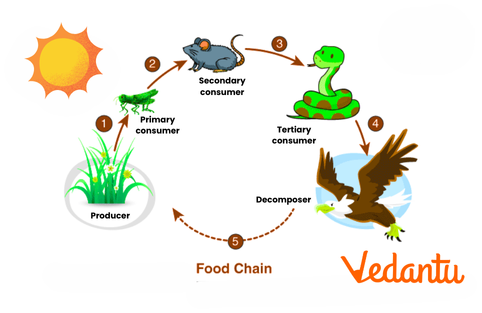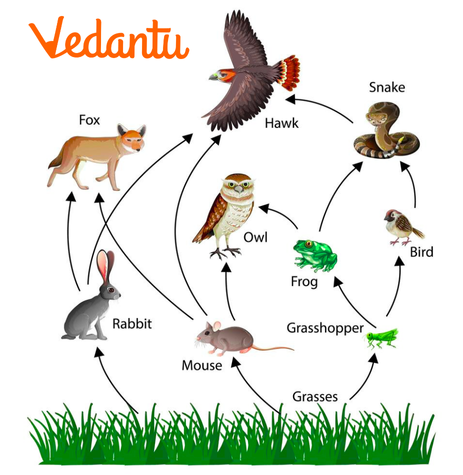Producers, Consumers, and Decomposers: Understanding Each Step
Imagine a game of survival where each organism relies on another for energy—this is the basic idea behind the food chain. At the heart of every ecosystem, a food chain describes how energy flows from one organism to another. Starting with producers like plants, energy travels up the chain to herbivores, carnivores, and decomposers. Understanding food chains helps us realise how interconnected life is and why preserving ecosystems is vital for survival. Let’s explore the key components of a food chain and the fascinating journey of energy as it moves through different trophic levels.
What is a Food Chain?
A food chain is a linear sequence that shows how energy and nutrients pass from one organism to another in an ecosystem. It starts with producers, organisms like plants that can make their own food using sunlight and flow upwards to consumers and decomposers. Each organism occupies a specific trophic level, which indicates its position in the food chain. The primary energy source is the Sun, which fuels all life on Earth through photosynthesis.

Key Components of a Food Chain
The Sun: The sun is the primary source of energy for all ecosystems. Through photosynthesis, producers convert solar energy into chemical energy, which serves as food for other organisms.
Producers (Autotrophs): Producers, such as plants, algae, and certain bacteria, are the foundation of every food chain. They capture sunlight and produce their own food, providing energy for all other life forms. Without producers, the entire food web would collapse.
Consumers (Heterotrophs): Consumers are organisms that rely on other organisms for food. There are different types of consumers:
Primary consumers (Herbivores): Animals that feed directly on producers, such as cows and rabbits.
Secondary consumers (Carnivores): Animals that eat primary consumers, such as wolves and snakes.
Tertiary consumers (Apex predators): These top predators have no natural predators of their own, such as lions or killer whales.
Decomposers: Decomposers, such as fungi, bacteria, and earthworms, break down dead plants and animals. This recycling process is crucial as it returns nutrients to the soil, enriching it for producers to use in the next cycle.
What is a Food Web?
While a food chain is a simple linear progression of energy flow, a food web is much more complex. It consists of multiple interconnected food chains within an ecosystem, highlighting the various feeding relationships among different organisms. Food webs are essential for maintaining ecosystem stability as they provide multiple pathways for energy flow, making ecosystems more resilient.

Types of Food Chains
Grazing Food Chain: In this type of food chain, energy starts with green plants (producers), moves to herbivores (primary consumers), then to carnivores (secondary consumers), and may extend to apex predators (tertiary consumers). This is the most common type of food chain, seen in most ecosystems like forests and grasslands.
Detritus Food Chain: This food chain begins with dead organic matter (detritus) and involves organisms like bacteria, fungi, and worms, which break down the detritus. These organisms are eaten by larger consumers like insects and small animals, which in turn are consumed by carnivores. Detritus food chains are common in environments rich in decomposing organic matter, such as forests or ocean floors.
Real-World Applications of Food Chains
Conservation Efforts: Understanding food chains is vital for wildlife conservation. Disruptions to one part of the chain can lead to cascading effects, impacting species survival and biodiversity. For example, removing apex predators can result in an overabundance of herbivores, which might lead to the depletion of plants.
Agricultural Practices: Farmers utilise knowledge of food chains to control pests and protect crops. For instance, introducing natural predators (like ladybugs) to control aphid populations is an application of food chain principles in agriculture.
Ecosystem Management: Food chains help environmental scientists monitor and manage ecosystems. By understanding which species depend on others, we can better predict how changes in the environment, such as pollution or habitat destruction, will affect the balance of an ecosystem.
Fun Facts About Food Chains
Apex predators often have fewer natural enemies because they sit at the top of the food chain.
Food chains can vary dramatically between ecosystems—desert food chains are much shorter than tropical rainforest chains due to the difference in biodiversity.
Decomposers are unsung heroes—without them, nutrients would not return to the soil, and new plants would struggle to grow.
Interactive Quiz: Test Your Knowledge!
What is the first level of the food chain?
A) Decomposers
B) Producers
C) Secondary consumers
D) Herbivores
Which of these is a secondary consumer?
A) Rabbit
B) Lion
C) Frog
D) Grasshopper
What role do decomposers play in an ecosystem?
A) They produce energy
B) They recycle nutrients
C) They consume plants
D) They make food through photosynthesis
Check Your Answers:
B) Producers
C) Frog
B) They recycle nutrients


FAQs on Food Chain Explained: Energy Transfer & Key Roles
1. What is a food chain and what is its primary role in an ecosystem?
A food chain is a linear sequence that illustrates how energy and nutrients are transferred from one organism to another. Its primary role is to show the flow of energy, starting from producers (like plants) that create their own food, moving up to various levels of consumers, and finally to decomposers. It is fundamental for maintaining the structure and balance of an ecosystem.
2. What is the main difference between a food chain and a food web?
The main difference lies in their complexity and realism. A food chain represents a single, linear pathway of energy flow (e.g., grass → deer → tiger). In contrast, a food web is a more complex and realistic model, consisting of multiple interconnected food chains that show how most organisms have more than one food source, making the ecosystem more resilient.
3. How does energy flow from one trophic level to the next in a food chain?
Energy flows directionally from lower to higher trophic levels. It begins with solar energy captured by producers (1st trophic level). When a primary consumer (2nd trophic level) eats a producer, it gains some of that energy. This transfer continues to secondary and tertiary consumers. However, at each step, a significant amount of energy is lost as heat during metabolic processes.
4. Why is the energy transfer between trophic levels in a food chain so inefficient?
The energy transfer is inefficient due to the 10% Law. Only about 10% of the energy from one trophic level is stored as biomass and passed on to the next. The remaining 90% is used by the organism for its own life processes like respiration, movement, and reproduction, or is lost to the environment as heat. This is why food chains rarely have more than four or five trophic levels.
5. What are the two main types of food chains found in ecosystems?
The two main types of food chains are:
- Grazing Food Chain: This chain starts with green plants (producers) as the primary energy source. Energy then flows to herbivores (primary consumers) and subsequently to carnivores. Example: Grass → Grasshopper → Frog → Snake.
- Detritus Food Chain: This chain begins with dead organic matter (detritus), such as dead leaves or animal remains. It is consumed by decomposers and detritivores (like fungi, bacteria, and earthworms), which are then eaten by larger organisms.
6. What happens to a food chain if a key species, such as an apex predator, is removed?
Removing a key species, especially an apex predator, can trigger a trophic cascade, severely disrupting the ecosystem's balance. The population of its primary prey (secondary consumers) might increase uncontrollably. This can lead to overconsumption of their food source (primary consumers or producers), potentially causing a population crash at lower levels and a loss of biodiversity.
7. How do decomposers, like bacteria and fungi, play a crucial role in the food chain?
Decomposers are essential because they act as nature's recyclers. They break down dead plants and animals from all trophic levels, returning vital nutrients like nitrogen and phosphorus to the soil and water. This process makes the nutrients available again for producers to use, thus completing the nutrient cycle and ensuring the long-term sustainability of the ecosystem.
8. How does the concept of biomagnification relate to the structure of a food chain?
Biomagnification is the process where certain persistent toxins (like DDT or mercury) become more concentrated in organisms at successively higher trophic levels. Because energy is lost at each level, top predators must consume large quantities of prey to meet their energy needs. This leads to them accumulating all the toxins from the lower levels, often reaching harmful or lethal concentrations in their bodies.
9. How can human activities such as pollution and deforestation disrupt food chains?
Human activities can have devastating effects. Deforestation destroys habitats, removing producers and other organisms from the base of the food chain. Pollution, such as oil spills or chemical runoff, can kill organisms directly or introduce toxins. Overfishing can remove key consumer species. All these actions break links in the food web, reduce biodiversity, and can lead to the collapse of entire ecosystems.










